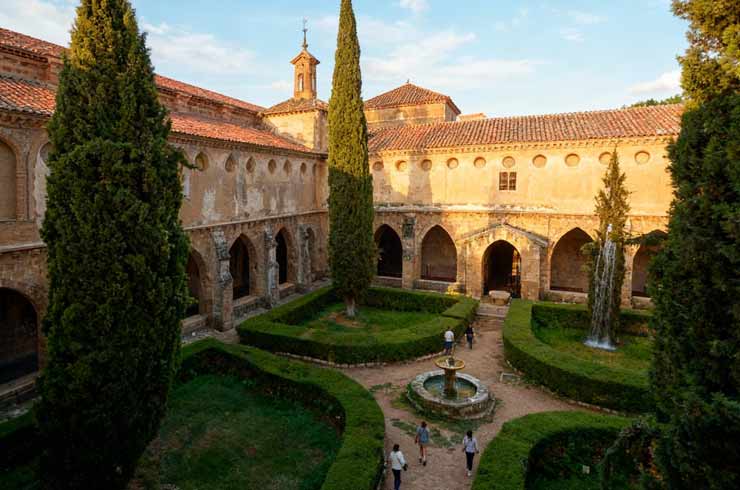In the heart of Aragón, nestled among gorges, waterfalls, and dense forests, stands a place where water speaks, stone sings, and history whispers to the visitor: the Monasterio de Piedra.
This is not just a monastic complex — it is a setting where nature and cultural heritage merge to create a unique and unforgettable experience.
If you’re planning a getaway from Zaragoza, Madrid, or anywhere in northeastern Spain, this site awaits you with a journey that blends medieval art, landscaped gardens, cascading waterfalls, mysterious caves, and legendary tales.
In this article, I’ll guide you through everything that makes the Monasterio de Piedra so special: its history, natural surroundings, hidden secrets, practical travel tips, and nearby routes.
Throughout this virtual journey, you’ll discover:
- Its location, how to get there, and what makes it unique.
- The centuries-old history of the Cistercian monastery and how it has evolved.
- What to see, from the cloister to the most hidden waterfalls.
- Practical tips to plan your visit (opening times, prices, gear).
- Nearby trails, fun facts, and the importance of the Monasterio de Piedra in Aragón’s tourism scene.
Ready to explore this legendary place? Let’s begin with the first chapter: Where is the Monasterio de Piedra, and why is it so special?
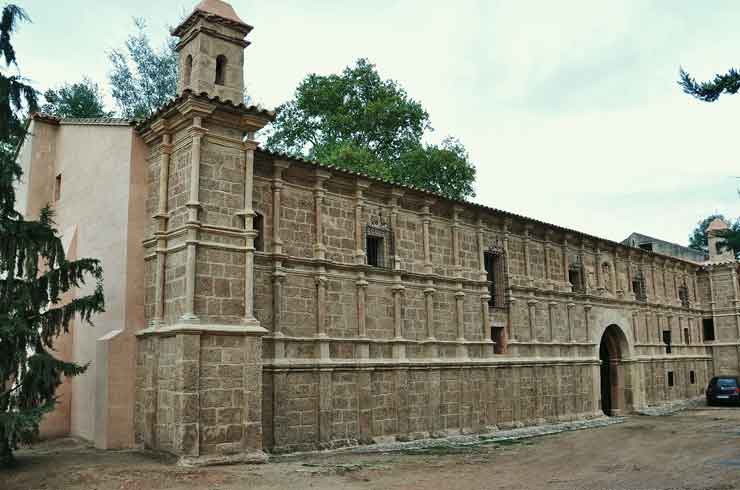
Where is the Monasterio de Piedra and Why is it So Special?
Location and How to Get There from Zaragoza or Madrid
The Monasterio de Piedra is located in the municipality of Nuévalos, within the comarca of Calatayud, in the province of Zaragoza, part of the Aragón region.
It sits beside the Piedra River, in a mountainous area of the Iberian System in southern Aragón.
How to get there:
- By car: From Zaragoza, take the A‑2 motorway towards Madrid until Calatayud, then follow the local road to Nuévalos (approximately 118 km in total).
- By train and bus: You can take a train to Calatayud and continue from there by bus or taxi to Nuévalos.
- Signage and access: The monastery complex is well signposted, with outdoor parking and pedestrian access to the natural park area.
This location offers a perfect blend of accessibility and peaceful seclusion, ideal for those seeking nature, history, and tranquility in one destination.
📍 Planning to explore more of Aragon after visiting the Monasterio de Piedra? Don’t miss this guide to the best things to do in Calatayud — a charming nearby town full of history, wine, and architecture.
What Makes the Monasterio de Piedra Unique?
What sets this place apart is its fusion of historical heritage and stunning natural landscapes.
It’s not just an ancient Cistercian monastery — it’s also a historic garden filled with waterfalls, caves, pathways, and magical corners.
Highlights that make it special:
- A harmonious mix of religious architecture and vibrant nature: stone, water, and vegetation.
- Numerous waterfalls, streams, and caves that transform the visit into a multi-sensory experience.
- A romantic and enchanting atmosphere, perfect for cultural getaways, family trips, or nature walks.
- Its status as one of the most visited tourist attractions in Aragón.
Check out our full-day tour to the Piedra Monastery from Zaragoza: Full-Day Tour to the Piedra Monastery
An Unmatched Natural Setting: Park, Waterfalls, and Caves
The natural park surrounding the monastery is the heart of the experience.
It has been carefully designed to enhance the beauty of water, rock formations, and the lush riverside forest.
Key features of the area include:
- Marked trails spanning 4 to 5 km, connecting viewpoints, waterfalls, lakes, and caves.
- Iconic waterfalls such as Cola de Caballo, La Caprichosa, and Iris, among others.
- Natural caves carved by centuries of flowing water, open to exploration.
- A rich riverside ecosystem, with lush vegetation and striking karst formations shaped by the Piedra River.
- Scenic viewpoints offering panoramic views of the park and the monastery in its full natural context.
All of this makes a visit to the Monasterio de Piedra a true immersion in living nature — far beyond just a historical site.
History of the Monasterio de Piedra
Cistercian Origins: Foundation and Early Centuries
The Monasterio de Piedra was founded in 1194 by a group of Cistercian monks from the Monastery of Poblet (Tarragona), under the command of King Alfonso II of Aragón.
Their goal was to establish a new spiritual center following the strict principles of the Cistercian order: austerity, manual labor, communal life, and silence.
The location, by the banks of the Piedra River, provided the necessary isolation, water resources, and natural surroundings for monastic life.
The monastery was built over the ruins of an old Muslim fortress and expanded during the 13th and 14th centuries.
During this time, its main buildings were completed: the church, cloister, refectory, chapter house, and monks’ cells.
The architectural style is Cistercian Gothic — simple, functional, and profoundly harmonious.
During this period, the Monasterio de Piedra became a spiritual, agricultural, and cultural landmark in the region.

Transformation into a Tourist Destination
The story of this place changed dramatically after the Spanish Confiscation (Desamortización de Mendizábal) in 1835, when the monks were expelled and the monastery passed into private hands.
It was then that the Muntadas family launched a pioneering project: to transform the site into an unprecedented tourist destination.
By the 19th century, the Monasterio de Piedra had become one of the first places in Spain to combine tourism, nature, and historical heritage.
A landscaped park was designed around the ruins, with trails, waterfalls, and caves that today form the heart of the experience.
Rest areas, a hotel, a restaurant, and visitor services completed this proposal, preserving the spiritual essence of the site while adapting it to a new era of travelers in search of inspiration, beauty, and a deeper connection with nature.
Today, nearly 200 years later, the monastery remains a shining example of how to preserve the past without turning away from the future.
Check out our full-day tour to the Piedra Monastery from Zaragoza: Full-Day Tour to the Piedra Monastery
The Monasterio de Piedra and the First Hot Chocolate in Europe
One of the most fascinating chapters in the history of the Monasterio de Piedra is its link to the introduction of chocolate in Europe. According to tradition, Fray Jerónimo de Aguilar — a Cistercian monk and companion of Hernán Cortés on his expedition to Mexico — returned with cacao seeds and knowledge of how to prepare the drink, which was still unknown in Europe at the time.
Back at the monastery, he taught his fellow monks how to prepare hot chocolate following the original method, marking a major moment in culinary history. It’s believed that the Monasterio de Piedra was the first place in Europe where hot chocolate was ever prepared — a fact that adds cultural and gastronomic significance to this sacred site.
A Lasting Legacy
Over the centuries, the monastery has withstood wars, looting, and abandonment — yet its spirit remains intact. Its Gothic arches, partially restored rooms, and the remains of its church reflect the passage of time and the enduring spiritual life once housed within its walls.
Today, the Monasterio de Piedra is more than just a historical relic — it is a symbol of rebirth, where nature has gently reclaimed what humanity left behind, creating a place of memory, peace, and beauty.
What to See at the Monasterio de Piedra: A Complete Visit
Tour of the Ancient Monastery
Cloister, Church, and Monastic Rooms
The visit begins at the 13th-century cloister, a sober and serene space that perfectly represents Cistercian style.
From there, visitors can explore other areas such as the church, chapter house, old abbey, refectory, kitchen, and calefactory (monks’ warming room).
Many of these rooms have retained their original structure, while others have been carefully restored.
Among the highlights is the exhibition on the History of Chocolate, which honors the monastery’s historical link to the introduction of this drink in Europe.
The architecture blends Gothic, Baroque, and Mudéjar elements, reflecting the building’s evolution over the centuries.
Living History Within Centuries-Old Walls
Walking through the monastery’s halls is like stepping into the past.
Visitors can imagine the monks’ daily routines — prayer, study, and labor.
Some rooms now feature museum-style displays that explain their original function.
Other spaces host temporary exhibitions or display archaeological remains that help visitors understand the site’s ongoing transformation.
Check out our full-day tour to the Piedra Monastery from Zaragoza: Full-Day Tour to the Piedra Monastery
Exploring the Natural Park
Main Waterfalls: Cola de Caballo, La Caprichosa, Iris
The natural park is the crown jewel of the entire site. Spanning a roughly 5-kilometer route, it features numerous waterfalls, the most famous of which include:
- Cola de Caballo (Horse’s Tail): the most iconic, with an impressive drop and interior access via the Iris Cave.
- La Caprichosa: smaller but beautifully delicate, perfect for photography.
- Iris Cave: a cool, misty cave offering a unique view of the waterfall from the inside.
These waterfalls are surrounded by lush vegetation and a fresh, humid atmosphere that turns the walk into a deeply sensory experience.
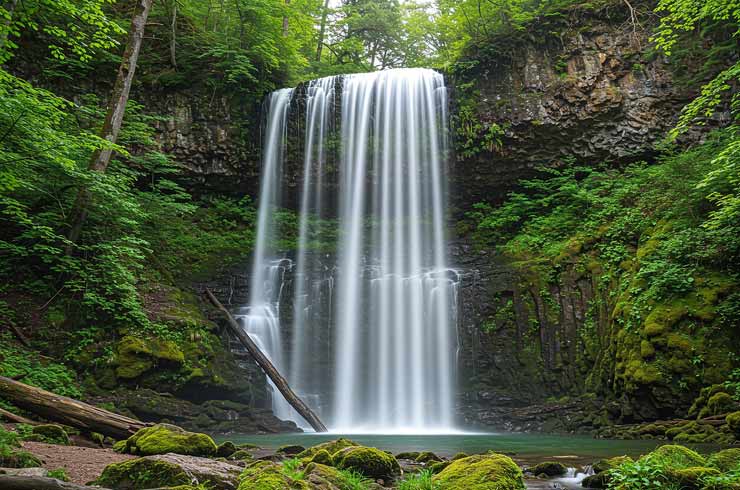
Caves, Lakes, and Unforgettable Landscapes
The trail also includes caves carved by water erosion, forested paths, small bridges, and magical corners like the “Lago del Espejo” (Mirror Lake), which reflects the sky and trees like a natural mirror.
The route features moderate inclines, stairways, and uneven terrain, so good walking shoes are recommended.
The full walk typically takes between two and three hours, depending on pace and how often you stop to admire the views.
🌲 If you love nature and breathtaking landscapes, take your adventure further with our guide to Ordesa and Monte Perdido National Park — one of Spain’s most spectacular natural wonders.
Interpretation Center and Wine Museum
The experience also includes an interpretation center with a small museum dedicated to the wines of the Calatayud Designation of Origin.
Inside, you’ll find old tools, informative displays, and exhibits that show the historic connection between wine and monastic life.
Occasionally, wine tastings, guided tours, and educational activities are offered — adding an enriching cultural layer to your visit.
Tips for Visiting the Monasterio de Piedra
Opening Times, Tickets, and Prices
To make the most of your visit, it’s a good idea to check the opening hours, which vary by season. Generally, the park opens between 9:00 a.m. and 6:00 or 8:00 p.m.
Tickets can be purchased at the entrance, but it’s advisable to buy them online to skip queues.
Discounts are available for children, seniors over 65, large families, and groups. You can also book package deals that include meals or accommodation.
🍷 Want to taste the region in a different way? Learn about gastronomic tourism in Zaragoza — from local olive oils to award-winning wines and authentic tapas experiences.
Best Time of Year to Visit
While the Monasterio de Piedra is open all year round, the best times to visit are spring and autumn, when the waterfalls are full and the surrounding landscape is especially vibrant.
In summer, visiting early in the morning is ideal to avoid the heat and crowds. Winter offers a quieter experience, although some areas may be damp or slippery.
What to Bring: Footwear, Clothing, and Practical Tips
For a comfortable visit, we recommend bringing:
- Comfortable, non-slip walking shoes or hiking boots.
- Seasonal clothing: warm layers in winter, light wear in summer.
- Sun protection, a hat, and sunglasses in sunny months.
- A refillable water bottle.
- A camera or fully charged phone for photos — the scenery is breathtaking!
You may also bring your own food and enjoy a picnic in the designated rest areas outside the park — perfect for relaxing after the walk.
Where to Eat and Stay Nearby
Inside the complex, the Hotel Monasterio de Piedra & Spa offers a charming stay in former monastic cells converted into comfortable rooms.
There’s also an on-site restaurant serving traditional Aragonese cuisine made with local ingredients.
For more budget-friendly options, the nearby town of Nuévalos and surrounding areas offer rural guesthouses, hostels, and restaurants — many with views of the La Tranquera Reservoir or nestled in nature.
Check out our full-day tour to the Piedra Monastery from Zaragoza: Full-Day Tour to the Piedra Monastery
Routes and Excursions Near the Monasterio de Piedra
The Water Route and Other Natural Gems in Calatayud
A visit to the Monasterio de Piedra pairs wonderfully with other nearby excursions, as the Calatayud region offers spectacular landscapes, charming villages, and rich natural surroundings.
One of the most recommended is the Water Route, which winds through reservoirs, springs, waterfalls, and unique geological formations. This route can be explored by car or bicycle, stopping at points such as:
- La Tranquera Reservoir, perfect for water activities and photography.
- The Roman dam of Muel, a remarkable example of ancient engineering.
- The Fountain of the 20 Spouts in Daroca, a symbol of historic water use.
You can also explore riverside trails and natural swimming spots along the Piedra River, especially in spring and summer.
Other Monasteries in Aragón Worth Visiting
If you’re passionate about monastic and cultural heritage, Aragón is home to other stunning monasteries — some lesser known, but equally impressive:
- Monasterio de Veruela, in the Campo de Borja region, surrounded by vineyards and deeply linked to wine culture and the poet Bécquer.
- Monasterio de Rueda, on the banks of the Ebro River, known for its innovative medieval hydraulic system.
- Monasterio de San Juan de la Peña, built into a rock face and wrapped in medieval legend, located in the Pyrenees.
All of them are well connected and can form part of a thematic route through the monasteries of Aragón — a fascinating cultural journey that perfectly complements your visit to the Monasterio de Piedra.
🏰 Looking for more medieval charm? Discover what to do in Albarracín, a fairytale village considered one of the most beautiful in Spain.
Curiosities and Secrets of the Monasterio de Piedra
Films, Series, and Shoots at the Monastery
Thanks to its magical atmosphere, monumental ruins, and stunning natural surroundings, the Monasterio de Piedra has served as the backdrop for numerous films, photo shoots, and documentaries.
Some productions have used its waterfalls and caves to recreate fantasy or historical settings.
Though not as widely known in media as other landmarks, its ambiance has drawn directors seeking unique, emotionally evocative locations.
It has also appeared in various travel and nature programs aired by RTVE, Aragón TV, and international broadcasters.
🛡️ Fascinated by history and fortresses? Don’t miss our complete guide to visiting Loarre Castle — one of the best-preserved Romanesque castles in Europe.
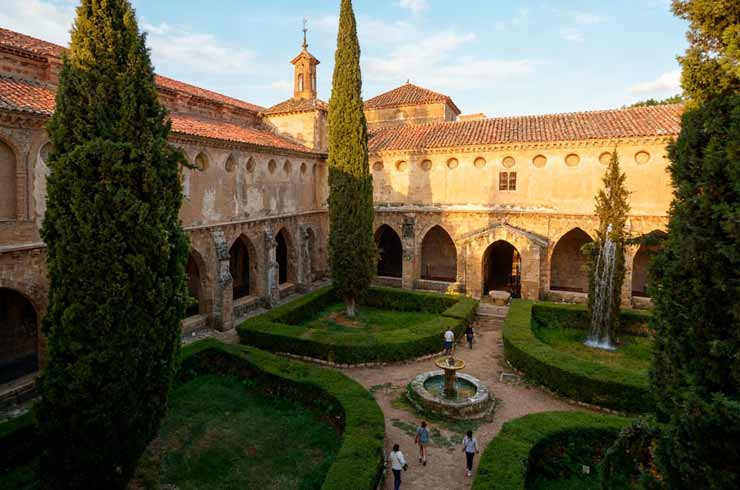
The Legend of the Monks and the Magical Fountain
Like many places with centuries of history, the Monasterio de Piedra is surrounded by legends.
One of the most popular tells of a hidden fountain that granted wisdom to those who drank from it in silence and deep reflection. It’s said that only the most devout monks knew its exact location.
Another local tale claims that the echo of the monks’ prayers can still be heard among the park’s caves, especially at dusk, when sunlight filters through the trees and the water sings its own melody.
Though undocumented, these stories add a special charm to the visit and remind us that heritage is measured not only in stone but in the emotions it awakens.
Check out our full-day tour to the Piedra Monastery from Zaragoza: Full-Day Tour to the Piedra Monastery
Surprising Flora and Fauna in the Park
The natural surroundings of the Monasterio de Piedra host remarkable biodiversity. As you wander the trails — especially at a slow pace — you might spot:
- Birds of prey like booted eagles, black kites, or peregrine falcons.
- Aquatic species such as trout in the streams or amphibians among the plants.
- Lush riverside vegetation, including willows, poplars, hazel trees, and ferns.
There’s also a dedicated area for raptor conservation and birdwatching, where educational demonstrations are offered. These initiatives raise awareness about protecting the environment and its native species.
These small discoveries make every visit feel alive — there’s always something new to see or learn.
The Monasterio de Piedra with Children or Groups
Recommended Activities for Families
Visiting the Monasterio de Piedra as a family is an unforgettable experience for all ages. The environment is safe, natural, and highly stimulating for children, who can freely explore paths, waterfalls, and caves that spark their imagination.
Suggested activities include:
- Exploring the park like a nature adventure: bridges, caves, and natural stairways capture children’s curiosity.
- Counting waterfalls, spotting birds, and identifying shapes in rocks and water.
- Attending the birds of prey show, where kids learn and have fun at the same time.
The site also includes rest areas, bathrooms, and a family-friendly restaurant — making logistics simple and stress-free.
Guided Tours and School Visits
Many schools include the Monasterio de Piedra in their educational trips thanks to its natural, historical, and educational value. There are customized itineraries for all age levels, combining nature, history, and environmental learning.
These tours are typically led by expert guides who adapt their explanations to the age of the group. Educational materials, group activities, and teacher-friendly resources are also available.
In addition to school groups, tours can be arranged for cultural associations, photography clubs, nature lovers, and more.
Is It Accessible for People with Reduced Mobility?
Accessibility is a key consideration at the Monasterio de Piedra. While some areas of the park have uneven surfaces, stairs, or slopes, much of the monastery and the park have adapted paths, railings, and clear signage.
The site offers:
- Tickets for visitors with reduced mobility.
- Reserved parking areas.
- Accessible restrooms and flat access points in the monastery area.
However, it’s always best to check the official website or contact staff in advance to plan a visit suited to the group’s specific needs.
The Monasterio de Piedra and Its Impact on Tourism in Aragón
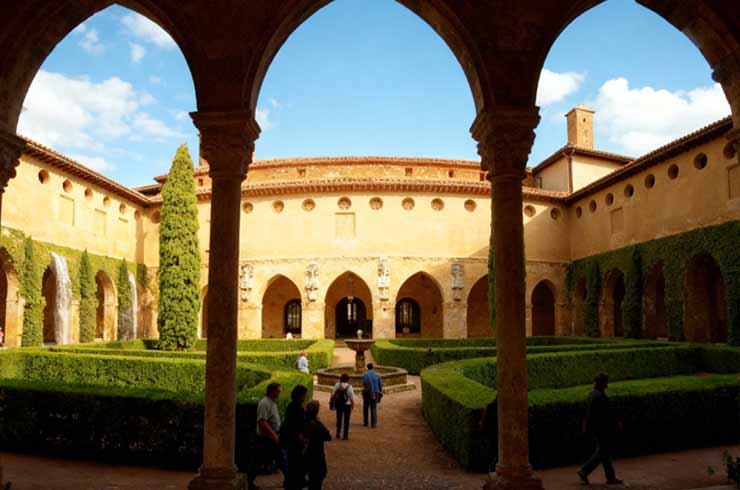
Cultural, Economic, and Environmental Importance
The Monasterio de Piedra is not only one of Zaragoza’s most visited destinations, but also a leading example of cultural and nature-based tourism in all of Aragón. Its ability to blend historical heritage, living nature, and activities for all audiences makes it a key driver of local and regional development.
Its influence extends well beyond tourism alone:
- It creates direct and indirect jobs in Nuévalos and the Calatayud region.
- It encourages the growth of local businesses, restaurants, and accommodations.
- It promotes rural tourism, hiking, and wine tourism in the area.
From a cultural standpoint, it stands as a prime example of how to preserve monastic legacy in a setting that enhances and respects natural values.
📸 Extend your route through southern Aragon and explore the top attractions in Teruel — a UNESCO World Heritage city full of Mudéjar art and romantic legends.
The Park’s Sustainable Tourism Model
In recent years, the management team at the Monasterio de Piedra has developed a tourism strategy focused on sustainability, environmental education, and ecological respect. This includes:
- Visitor capacity controls to protect trails and ecosystems.
- Educational programs to raise awareness about the importance of water, flora, and fauna.
- Efficient use of water and energy in facilities.
This approach positions the site as a model for how historical monuments can become immersive natural experiences without sacrificing sustainability.
Current Conservation and Education Projects
Beyond tourism, the Monasterio de Piedra serves as a hub for cultural and educational development. Recent projects include:
- Restoring new areas of the monastery to expand the visitable route.
- Hosting temporary exhibitions, cultural events, and lectures.
- Collaborations with schools, foundations, and universities to study and share its natural and historical heritage.
The ongoing commitment to preserving both architectural and ecological heritage makes this destination far more than just a beautiful place to visit.
Check out our full-day tour to the Piedra Monastery from Zaragoza: Full-Day Tour to the Piedra Monastery
Conclusion: Why You Should Visit the Monasterio de Piedra at Least Once in Your Life
After learning its history, walking among its waterfalls, exploring its caves, and discovering its secrets, one thing is clear: the Monasterio de Piedra is one of those places that leaves a lasting impression.
Whether you travel solo, with a partner, family, or friends, this corner of Aragón has something special to offer: peace, beauty, wonder, and discovery. Every visit feels different — the light changes with the seasons, the forest sings with the water, and the energy is ever renewed.
Here’s why it’s a must-visit:
- It’s one of the most spectacular natural landscapes in Spain.
- It holds a Cistercian monastery rich in history and symbolism.
- It offers a multi-sensory experience suitable for all ages.
- It’s the perfect blend of nature, culture, gastronomy, and wellness.
- It’s just a short trip from Zaragoza, in the heart of Calatayud.
At Rutica 41, we invite you to experience the Monasterio de Piedra like never before — with expert guides, custom tours, and immersive itineraries tailored to your style of travel.
Are you ready to explore this legendary place with us?
Contact us and discover an unforgettable escape.

